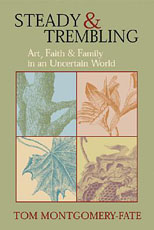"A few weeks later I spent a day at The Cenacle, a nearby Catholic retreat center. Upon leaving, I noticed a poster in the main hallway. The poster featured a series of short sentences with dark letters overlaid against a yellow and brown watercolor wash. The stack of words is titled 'Original Sin.'
"He is not perfect. She is not perfect. They are not perfect. I am not perfect. You are not perfect. We are not perfect. It is not perfect.
"This seemed like a script from one of those Saturday Night Live feel-good therapy sketches. But not when I reread it a few times. The repetitive 'not,' the inclusion of six personal pronouns, and the enormity of the seventh — of 'it' — troubled me.
"The word perfect is often defined as flawlessness, yet a central Latin root of the word offers another less-known definition: 'completeness.' The perfection an artist seeks is not flawlessness, but beauty — a sense of the whole of creation captured in a tiny piece of it — in the slow curves of a melody or a sentence or in the boney 'S' of the human spine.
"On a radio show today I heard some TV star described as having 'a perfect body.' I didn't know who the host was referring to, but I knew what. Here 'perfect' means thin, well-toned, clear-skinned — Barbie- or Ken-like — camera-ready for an underwear or bra commercial. Such media-driven perceptions of beauty are destructive — particularly for adolescents, whose bodies are still blooming into fullness. TV beauty is epitomized by an 'extreme makeover': normal (flawed) people seeking abnormal (flawless) bodies and lives. Surgeons cut away wrinkles, suck out fat, shorten noses, inflate lips, and tuck in cheeks. Beauty is flawlessness, rather than wholeness, appearance rather than essence.
"I see this everywhere. On this warm March day a man in a brown uniform is spreading fertilizer on a neighbor's lawn. Soon he will spray pesticides and herbicides from his chemical truck with his chemical hose. Then he will plant his little white flag, officially surrendering to the façade of beauty. The chemicals kill everything except the Kentucky blue grass and the Georgia rye. The 'beauty' of a poison-perfect lawn is its homogeneity. It appears 'healthy,' but destroys plant diversity, a real sign of health. And the toxins leech into the nearby DuPage River, killing hundreds of plants and frogs and fish.
"One of the menacing weeds the lawn service man kills is the dandelion. I have mindlessly dug up thousands over the years with that little tool that looks like a metal snake tongue. But I don't anymore. I just never considered that maybe the grass was getting in their way rather than vice versa. Why did I change my mind? Because I know when Bennett picks one and blows the seeds skyward, and watches them ride the warm currents of air through the dappled sunlight, it will fill me with awe. And then I will do it too — pluck one of the bitter milky stems with its see-through globe of seed-topped filaments and blow them back to God.
"An artist seeks the beauty sleeping in everything.
"I think of Rembrandt wandering the streets of Amsterdam in the sixteenth century and finding the worn, forgotten faces of old men and women, the weeds that hadn't been pulled because no one noticed them. He found and framed and painted those tired, beaten faces with such compassion that they now hang as masterpieces in museums around the world. Rembrandt, like many artists, reveals that beauty is more about difference than sameness, more about flaw than its absence.
"Empty again, I return to my seeds file for inspiration and find Marvin Bell's lovely poem 'To Dorothy.' The first two lines capture in nine words what I've been trying to say for the last few hundred:
"You are not beautiful, exactly.
You are beautiful, inexactly.
"Amish quilts are also inexactly beautiful. These quilts are admired for their detail and delicate craftsmanship, but a closer look shows the seamstress always intentionally sews a flaw into each one, to express the nature of humanity — flawed yet whole. And these 'imperfections' add to the beauty and value of a quilt rather than detract from it.
"I think this is the central idea of Lamott's books: the quilt of a human life — of a family and a faith — requires flaw and ambiguity and vulnerability to be complete, to be whole. The only real 'advice' she ever offers for how to stitch together such a life is not new: Pay attention. 'Writing can give you what having a baby can give you: it can get you to start paying attention, can help you soften, can wake you up.'
"Art and faith are about waking up, and waking others up, again and again to the miracle of creation. The quality of my attention as a parent and writer may enable me to find God where I least expect God — in a patch of dandelions, in an old forgotten face, in a stack of my students' papers, in a child's innocent question."
